

Check Student Learning. Lee Haugen [Center for Excellence in Learning and Teaching] Iowa State University February, 1999 What are CATs?
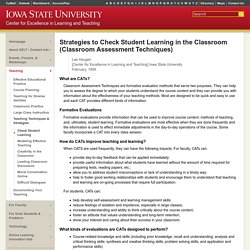
Classroom Assessment Techniques are formative evaluation methods that serve two purposes. They can help you to assess the degree to which your students understand the course content and they can provide you with information about the effectiveness of your teaching methods. Most are designed to be quick and easy to use and each CAT provides different kinds of information. Formative Evaluations Formative evaluations provide information that can be used to improve course content, methods of teaching, and, ultimately, student learning. Sewell_0310.pdf. Web 2.0 and Emerging Learning Technologies/Web 2.0 Learning Styles - Wikibooks, open books for an open world. Introduction It seems in the twenty-first century new learning technologies are appearing every day for teachers to think about.

With the advent of technology across all fields of learning, the ways in which learners store and retrieve information for further use has dramatically changed. Multimedia, interactive learning technologies, and collaborative learning are the new method which have been successfully deployed for conventional or unconventional learning. Previously, the different ways of learning were restricted to people who learn better visually, people who are more comfortable with words, and so on. These sensibilities are changing and are being tested by new ways of utilizing and integrating technology. Adult learning is on the rise and the usual models for addressing student learning do not apply any more. Theory of Multiple Intelligences in Conventional Learning Traditional Vs Neomillenial Model of Learning 1. 2. 3. 4. Catering to ‘digital’ intelligence 1. 2. Assessment. Assessment, Evaluation, Testing and Grading Craig L.

Scanlan, EdD, RRT What is Assessment? To many teachers (and students), “assessment” simply means giving students tests and assigning them grades. This conception of assessment is not only limited, but also limiting (see section below on Assessment versus grading). In the most general sense, assessment is the process of making a judgment or measurement of worth of an entity (e.g., person, process, or program). Motivating and directing learning providing feedback to student on their performance providing feedback on instruction and/or the curriculum ensuring standards of progression are met Learner assessment is best conceived as a form of two-way communication in which feedback on the educational process or product is provided to its key stakeholders (McAlpine, 2002).
For teachers and curriculum/course designers, carefully constructed learner assessment techniques can help determining whether or not the stated goals are being achieved. Classroom Assessment Techniques (CATs) A Guide for Faculty and Teaching Assistants The following guide is designed to explain and give examples of how in-class assessment can enhance university teaching and learning.
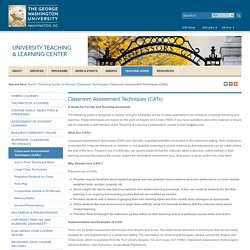
These techniques are based on the work of Angelo and Cross (1993). If you have questions about this material or would like to meet with a staff member at the Teaching & Learning Collaborative, please e-mail tlc@gwu.edu. Classroom Assessment Techniques in Asynchronous Learning Networks. Note: This article was originally published in The Technology Source ( as: Tom Henderson "Classroom Assessment Techniques in Asynchronous Learning Networks" The Technology Source, September/October 2001.
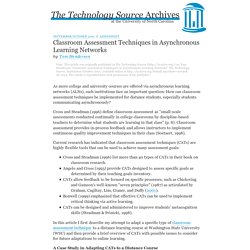
Available online at The article is reprinted here with permission of the publisher. As more college and university courses are offered via asynchronous learning networks (ALNs), such institutions face an important question: How can classroom assessment techniques be implemented for distance students, especially students communicating asynchronously? Classroom Assessment Techniques (CATs) Classroom Assessment Techniques (CATs) allow instructors to monitor students’ progress throughout the term.
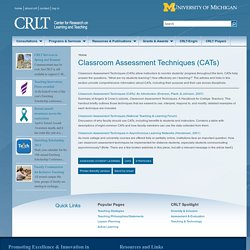
CATs help answer the questions, “What are my students learning? How effectively am I teaching?” The articles and links in this section provide comprehensive information about CATs, including their purpose and their use across disciplines. Summary of Angelo & Cross’s volume, Classroom Assessment Techniques: A Handbook for College Teachers. This handout briefly outlines those techniques that are easiest to use, interpret, respond to, and modify; detailed examples of each technique are included.
Classroom Assessment Techniques (CATs) Home » All CFT Teaching Guides » Classroom Assessment Techniques (CATs) What Are CATs?
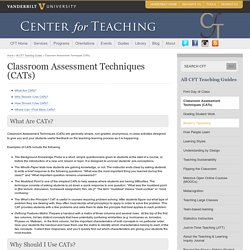
Classroom Assessment Techniques (CATs) are generally simple, non-graded, anonymous, in-class activities designed to give you and your students useful feedback on the teaching-learning process as it is happening. Examples of CATs include the following. The Background Knowledge Probe is a short, simple questionnaire given to students at the start of a course, or before the introduction of a new unit, lesson or topic. It is designed to uncover students’ pre-conceptions.The Minute Paper tests how students are gaining knowledge, or not. Why Should I Use CATs? CATs can be used to improve the teaching and learning that occurs in a class. How Should I Use CATs? Results from CATs can guide teachers in fine-tuning their teaching strategies to better meet student needs. Where Can I Find More CATs? A number of web sites also feature information on and examples of CATs, including the following. Classroom Assessment Techniques (CATs) CL-1: Field-tested Learning Assessment Guide (FLAG): Classroom Assessment Techniques (CATs)